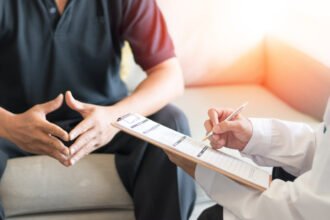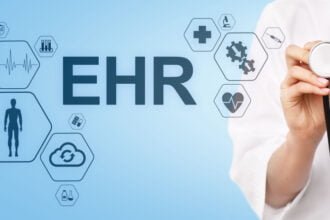 According to Rick Berenson, CEO of Thermalin Diabetes, insulin is a $14B per year market worldwide, yet there are shortcomings of the drug.
According to Rick Berenson, CEO of Thermalin Diabetes, insulin is a $14B per year market worldwide, yet there are shortcomings of the drug.  According to Rick Berenson, CEO of Thermalin Diabetes, insulin is a $14B per year market worldwide, yet there are shortcomings of the drug. Thermalin Diabetes, LLC is a Cleveland-based biotechnology company developing a portfolio of next generation insulin analogs. Founded on compounds invented by Dr. Michael Weiss, Chairman of Biochemistry at Case Western Reserve Medical School, Thermalin’s therapeutic proteins will address medical needs related to diabetes and its complications. Berenson will present the company’s technology at OneMedForum, January 9-12 in San Francisco. Below he is interviewed by OneMedRadio where he discusses the Coulter Process and the company’s future milestones.
According to Rick Berenson, CEO of Thermalin Diabetes, insulin is a $14B per year market worldwide, yet there are shortcomings of the drug. Thermalin Diabetes, LLC is a Cleveland-based biotechnology company developing a portfolio of next generation insulin analogs. Founded on compounds invented by Dr. Michael Weiss, Chairman of Biochemistry at Case Western Reserve Medical School, Thermalin’s therapeutic proteins will address medical needs related to diabetes and its complications. Berenson will present the company’s technology at OneMedForum, January 9-12 in San Francisco. Below he is interviewed by OneMedRadio where he discusses the Coulter Process and the company’s future milestones.
Click below to hear interview audio and see following transcript. To register to attend OneMedForum SF 2012, click here.
Brett Johnson: Brett Johnson here in New York with OneMedRadio. Today, we are with Rick Berenson. Rick is the CEO and co-founder of Thermalin, a Cleveland-based firm that’s developed a better insulin. Thanks for joining us today, Rick.
Rick Berenson: Hey, Brett. Thanks for having me.
BJ: So tell me, Rick, what is the better insulin? What have you guys developed there?
RB: Well it turns out that today’s insulins, you know, they work, they’re safe, but there are things that are generally recognized that they could be better at and I’ll give you three examples. The first is that insulins, particularly the ones that are taken at mealtimes don’t act fast enough. They take too long to get started and they last for too long after the meal. And that means that if you take insulin at mealtime, you end up with too much insulin on board after your meal has been digested that tends to drive down your blood sugar and you’re hungry, you’ll tend to snack and there’s weight gain associated with it. There are also problems with today’s insulins when it comes to the next generation of pumps that are going to need ultra-rapid insulins to work right. So today’s insulins just aren’t fast enough. We’re working on insulins that are 30% to 50% faster than today’s insulins.
Another example is insulins today aren’t concentrated enough. There are some people who are highly insulin resistant and they need to take very large quantities of insulin. These injections can be painful or if they’re on a pump, they could be changing their cartridges several times a day. And what they want is an insulin that basically has more insulin per unit of volume that you have to inject. We have an insulin that we have demonstrated can be five times as concentrated, but just as fast as regular insulin is at that kind of concentration. Regular insulin if you concentrate it like that, it’s going to last five to six hours which is just way too long to be practical.
And then a third area is that insulin today needs to be refrigerated, which is a convenience issue for most patients but not a huge deal. But if you are living down in the south for example and you want to have insulin delivered by a mail order, it’s going to sit outside in the heat, it’s going to bake and it’s going to go bad, and it’s just not practical to deliver by mail order today. Worse, if you are living in a developing country, which is where the growth of insulin consumption is going to be tremendous, it’s supposed to go up by a factor of 12 over the next 20 years, you often don’t have a cold chain of delivery. There’s often no way for people to get insulin to you in a practical way today because insulin has to be refrigerated. So for those two reasons, there’s a real need to get an insulin that doesn’t need to be refrigerated and we have insulins that are stable enough that particularly at the end of a delivery cycle, they don’t need to be refrigerated.
BJ: Interesting. Can you talk a little bit about the size of the market? I mean how big is the insulin market?
RB: Well insulin today is about $14B a year worldwide. It’s the largest volume drug in the world in terms of actual physical volume and it’s expected to grow at about 8% per year for the next 20 years. So $70B+, double in the US, triple in Europe and as I said go up by a factor of 12 in the rest of the world so this is a huge market.
BJ: And how many companies are playing in this market today?
RB: Well, the three major players today are Eli Lilly, Sanofi-Aventis, and Novo Nordisk and they really have — well they have basically 100% of the market in the western world. In the developing world, Russia, China, Brazil, India there are a number of other companies that are producing insulins.
BJ: So are there many new innovators coming up with new ideas like this to develop new types of insulin?
RB: Well so there are some folks who are working on long acting insulins, but our focus is not on just another long acting insulin. Our focus really is on the three niches that I described for you earlier. And while there are some people who are working on novel formulations of existing insulin, there aren’t any people that we’ve come across that are working on actual modifications to the insulin molecule itself to make it work better.
BJ: So where did this idea come from?
RB: Well, Mike Weiss who is the founder of Thermalin has actually been studying the insulin molecule for more than 25 years. He’s the chairman of biochemistry at Case Western Reserve now, but he got is M.D./Ph.D. at Harvard 25 years ago and was inspired by somebody to look at this molecule. Now for the past I would say 20 years, maybe 15 years, insulin has been something that people thought everything there was to know about it was already known. There were a number of new versions of the insulin molecule that were invented in the ’90s and then came out in the late ’90s and the early 2000s. They were great improvements. Humalog, Novolog, Lantus are probably the three leaders that people know about.
But after those came out in the market, people sort of stopped doing research, but Mike didn’t because he was interested in the fundamental science. He’s a physical biochemist, which means he kind of thinks about the shape of the molecule and how it interacts with other molecules. And his work which has been incredibly productive in understanding how it works and how it fits into the receptor that its job is to fit into, has progressed to the point where he got some real new insights on what you could do to make to the molecule work better. So by doing things like making some changes — insulin is a protein and so you can think of it as like a necklace. It’s a string of amino acids. And what Mike has done is not just change what some of the beads are, what the orders of the beads are, but he’s actually used some new beads. We’re using some what are called artificial amino acids that allow him to tweak the molecule in just a way to get these new improved behaviors. And so these new insights in the context of understanding what the environment for insulin is has a allowed us to have some really great breakthroughs in making this molecule work better.
BJ: So what about the intellectual property and the patent rights on your development?
RB: Well we have 10 patents that have been filed, all pending. We have some early and very promising office actions on them. They’re all owned by Case Western and exclusively licensed to Thermalin.
BJ: Right. And so where are you at in the stage of development of your company? Can you sort of give us a sense of where you are right now?
RB: Sure, absolutely. So we have a lab here in Cleveland. We’ve got seven scientists working. Their job is to make the insulin and to test it. We have managed to work ourselves up to the 100 mg manufacturing scale, which is actually enough scale to be able to get into early human trials. We’re not at the GMP yet, but that’s on our list of things to get done in the next year. And we’ve been doing quite a few studies in large animals. It’s critical to understand the behavior of insulin that you test it out in large animals and the preferred animal is a pig because the pig’s skin is very similar to a human skin. And so we basically do what you do to a person. You do what’s called a glucose clamp study and what that does is it tells you how fast does the insulin come on and how fast does it come off after you inject it. Using those studies, we’ve been able and — we’ve done I think 60 of these studies so far. We’ve been able to show that we have for example an ultra concentrated form of insulin that is as fast as Humalog. We’ve been able to show that we have ultra rapid acting insulin formulations that are about 25% to 30% faster than existing analogue formulations, not good enough yet, but we’re making great strides on it.
BJ: So, what is the regulatory pathway? At what point can this get approved?
RB: Well, you know, if we had all the funds in the world, our guess is we’d probably be approved in the oh let’s call it in the 2016, 2017 timeframe. But the path is it’s a very straightforward path. It’s not actually treated as a biologic despite being a protein, interestingly. Historically because of the path it’s come through, insulin is just treated as a small molecule. But the path is a very straightforward one.
What’s interesting about insulin is because there have been so many new forms of insulin that have been developed and tested on the market, the regulatory path is less expensive than it would be for almost all new small molecules. And by that I mean to run a phase I study, the cost is on the order of a half a million dollars. To run a phase II study, the cost is about $2M. And the reason it’s so inexpensive is that all of the toxicities and the behavior of insulin in the body is very well understood so the studies that need to be done are constrained and well identified based on history. Now of course you never know what the requirements are going to be with the FDA when you actually get in front of them and there are always concerns that you have to address and address appropriately, but nonetheless it is actually quite inexpensive to get initial human data from a new form of insulin.
BJ: Okay. Well let’s talk about financing. How much money is enough money in the world? How much are you trying to raise now?
RB: Well we’re in the process right now of raising an $8M B round. Our initial round of financing we had an A round of about $3M. We’ve also been successful in getting NIH support. We’ve got about $2M in NIH grants and continue to I think have a good track record with the NIH because of the solidness of the work that Mike Weiss has done. So the $8M is designed to let us take two of our target product profiles through a phase II study. But it’s our hope that with phase I data and the interesting thing about phase I data for insulin is that you get this key pharmacokinetic data that you need to show that it’s doing what you want it to do. Our hope is that with that we’ll be able to land one or more partnerships with major pharmaceutical companies to take these drugs forward to market.
BJ: Terrific. So who has been backing the company today? Who are the owners of the company today?
RB: Well Jumpstart Ventures, which is a seed stage funds here in Cleveland is probably our largest investor and most important backer. We also have a group in Boston called Massachusetts Medical Angels, which specializes in life science startups and we were one of their earliest investments and we have a lot of support from them. And the rest of the money has come from a number of angel investors that we’ve been able to attract. So far, the only institutional money, really formal institutional money has been from Jumpstart Ventures here in Cleveland.
BJ: So what is your background and how did you get involved in this project?
RB: Well I’m a serial life science entrepreneur. I’m based on Boston and I’ve done a whole series of startups there. I got a call from my college roommate a number of years ago who’s Mike Weiss. Mike said, Rick, do you know anybody who knows about starting a company because I’ve invented a new form of insulin that I think is just terrific and I said well yes, how about me. And so we started talking about what it would take to put a company together and really got going in 2009 and since then we have built I think a pretty solid team here including a guy by the name of Bruce Frank. Bruce was actually the co-inventor of Humalog, which was the first insulin analogue ever brought to the market. He also was on the team that brought Humalin, which was the first biotech product ever into Lilly from Genentech back in the ’80s. So he has a long history of understanding what it takes to bring new insulins to market. He’s our vice president of insulin development and just a tremendous source of wisdom and focus for us.
BJ: Terrific. Well it sounds very exciting. Thank you, Rick, for joining us today. That’s Rick Berenson who is the CEO and co-founder of Thermalin who will actually be presenting at the OneMed Forum in San Francisco on January 9th through 12th. So for more information about that, visit OneMed.com. Thanks again, Rick, for joining us today.
RB: It’s my pleasure. Thank you for the time.








